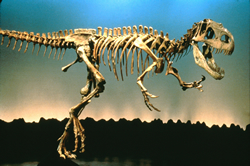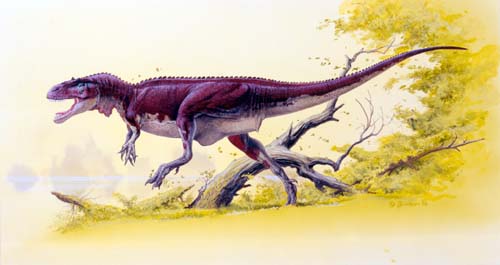Afrovenator abakensis - Cretaceous Dinosaurs
Homepage > Cretaceous Dinosaurs - Afrovenator abakensis
(AF-roh-VEN-uh-tehr)
"African Hunter"
Describer Sereno, Wilson, Larsson, Dutheil & Sues,
1994
Also Known As --
Type of Species abakensis
Order Saurischia
SubOrder Theropoda
InfraOrder --
Micro-Order --
Family Megalosauridae
Size 29.5 feet (9 meters) long
Period Early Cretaceous 136 to 125 million years ago
Fossilsite Tiouraren Formation, In Abaka, Niger
Diet Carnivore
 Afrovenator
is a genus of megalosaurid theropod dinosaur from the Early Cretaceous
Period of northern Africa. It was a bipedal predator, with a mouthful
of sharp teeth and three claws on each hand. Judging from the one skeleton
known, this dinosaur was approximately 30 feet (9 meters) long from snout
to tail tip.
Afrovenator
is a genus of megalosaurid theropod dinosaur from the Early Cretaceous
Period of northern Africa. It was a bipedal predator, with a mouthful
of sharp teeth and three claws on each hand. Judging from the one skeleton
known, this dinosaur was approximately 30 feet (9 meters) long from snout
to tail tip.
The generic name comes from the Latin prefix afro- "from Africa" venator "hunter". There is one named species, A. abakensis. The name refers to its predatory nature, and its location in Africa, specifically from In Abaka, the Tuareg name for the region of Niger where the fossils were found.
The original description of both genus and species is found in a 1994 paper which appeared in the prestigious journal Science. The primary author was well-known American paleontologist Paul Sereno, with Jeffrey Wilson, Hans Larsson, Didier Dutheil, and Hans-Dieter Sues as coauthors.
The remains of Afrovenator were discovered in the Tiourarén Formation of the department of Agadez in Niger. The Tiourarén most likely represents the Hauterivian to Barremian stages of the Early Cretaceous Period, or approximately 136 to 125 million years ago (Sereno et al. 1994). The sauropod Jobaria, whose remains were first mentioned in the same paper which named Afrovenator, is also known from this formation.
Afrovenator is known from a single nearly complete skeleton, featuring most of the skull (minus the mandible, or lower jaw), parts of the spinal column, hands, and forelimbs, a nearly complete pelvis, and complete hindlimbs. This skeleton is housed at the University of Chicago.

Image courtesy of John Bindon